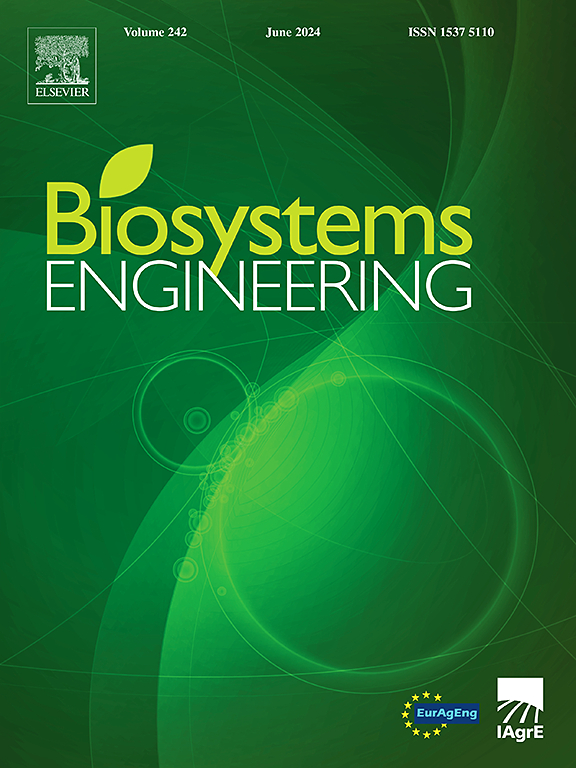鲜青大豆收割机脱粒性能的数值模拟与优化
IF 5.3
1区 农林科学
Q1 AGRICULTURAL ENGINEERING
引用次数: 0
摘要
本研究设计了一种自走式打浆滚筒收割机。通过材料力学性能测试,结合 Workbench 和工程离散元法工程离散元法(EDEM)模拟软件,对收割过程中的漏收率和损坏率进行了系统分析。使用 Workbench 验证了青豆荚的压缩性能,结果与实验数据高度一致。建立了打浆机脱浆性能的动态模型,并进行了正交回归实验,以研究滚筒转速(A1)、切割平台高度(B1)和前进速度(C1)的影响。结果表明,漏割率和损坏率模型非常显著(p < 0.0001)。利用 EDEM 软件模拟不同的操作条件和因素组合,对收割机的漏割率(Y1)、损坏率(Y2)和总损失率(YT)进行了深入研究。模拟结果与实验验证之间的最大预测误差为 9.78%。为了将总损失降至最低,对参数进行了优化,得出了以下最佳组合:YT 为 10.8%,Y1 为 6.9%,Y2 为 3.9%。相应的 C1 为 0.67 m s-1,A1 为 305 r. min-1,B1 为 40 mm。模拟分析、模型预测和实验验证的误差均在 9.8% 以内。这项研究为鲜青大豆收割机的优化设计提供了科学指导。本文章由计算机程序翻译,如有差异,请以英文原文为准。
Numerical simulation and optimisation of depodding performance in a fresh green soybean harvester
A self-propelled beater drum harvester was designed in this study. A systematic analysis of the missed harvest and damage rates during the harvest process was conducted through material mechanical performance testing combined with Workbench and engineering discrete element method engineering discrete element method (EDEM) simulation software. Workbench was used to validate the compression performance of green soybean pods, and the results were highly consistent with the experimental data. A dynamic model for the beater depodding performance was established, and an orthogonal regression experiment was conducted to investigate the effects of drum rotating speed (A1), cutting platform height (B1), and forward speed (C1). The results showed that the models for missed harvest and damage rates were highly significant (p < 0.0001). Using EDEM software, different operational conditions and combinations of factors were simulated to conduct an in-depth study of the missed harvest rate (Y1), damage rate (Y2), and total loss rate (YT) the harvester. The maximum prediction error between the simulation results and experimental validation was 9.78 %. To minimise total loss, the parameters were optimised, yielding the following optimal combination: YT of 10.8 %, Y1 of 6.9 %, and Y2 of 3.9 %. The corresponding C1 was 0.67 m s−1, A1 was 305 r. min−1, and B1 was 40 mm. The errors in the simulation analysis, model prediction, and experimental validation were all within 9.8 %. This study provides scientific guidance for optimising the design of fresh green soybean harvesters.
求助全文
通过发布文献求助,成功后即可免费获取论文全文。
去求助
来源期刊

Biosystems Engineering
农林科学-农业工程
CiteScore
10.60
自引率
7.80%
发文量
239
审稿时长
53 days
期刊介绍:
Biosystems Engineering publishes research in engineering and the physical sciences that represent advances in understanding or modelling of the performance of biological systems for sustainable developments in land use and the environment, agriculture and amenity, bioproduction processes and the food chain. The subject matter of the journal reflects the wide range and interdisciplinary nature of research in engineering for biological systems.
 求助内容:
求助内容: 应助结果提醒方式:
应助结果提醒方式:


